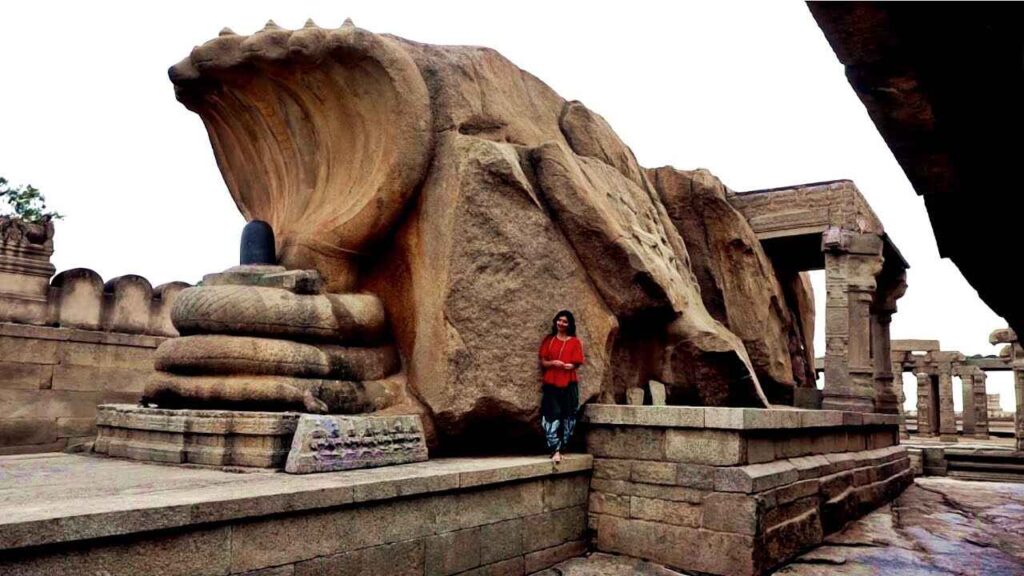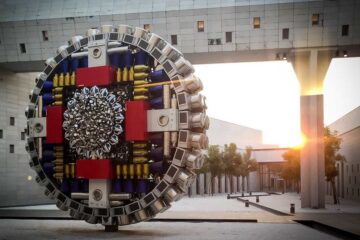Lepakshi Temple, located in the Anantapur district of Andhra Pradesh, India, is a marvel of architecture and a testimony to the incredible craftsmanship of the Vijayanagara Empire. With its stunning sculptures, intricate carvings, and fascinating legends, Lepakshi Temple is a must-visit destination for anyone interested in Indian history and culture. In this blog, we will explore the history and significance of Lepakshi Temple, as well as the various architectural wonders and legends associated with this magnificent temple.
Lepakshi Temple Overview
Lepakshi Temple is considered one of the finest examples of the Vijayanagara style of architecture and is dedicated to Lord Shiva. The temple is known for its intricate carvings, stunning architecture, and rich history.
The temple was built in the 16th century by the Vijayanagara Empire’s kings and is believed to have been completed during the reign of King Achutaraya. The temple complex is spread over 40 acres and has three main sections: the Natya Mantapa, the Ardha Mantapa, and the Garbhagriha. The Natya Mantapa is the main hall of the temple, where dancers used to perform during festivals. The Ardha Mantapa is a smaller hall that leads to the Garbhagriha, which is the sanctum sanctorum of the temple.
Lepakshi Temple is famous for its stunning architecture, especially its hanging pillar, which is a marvel of engineering. The pillar is suspended from the ceiling and is not in contact with the ground. It is believed that the British tried to move the pillar to see how it was suspended, but they were unable to do so.
The temple is also known for its intricate carvings, especially the ones that depict scenes from the Ramayana and the Mahabharata. The most famous carving in the temple is that of the bird Jatayu, who is believed to have died while trying to save Sita from Ravana.
Lepakshi Temple is an important pilgrimage site for Hindus and attracts a large number of devotees every year. It is also a popular tourist destination and is known for its stunning architecture, rich history, and religious significance.

lepakshi temple history
Lepakshi Temple is a significant cultural and historical landmark located in the Anantapur district of Andhra Pradesh, India. Built during the 16th century by the brothers Viranna and Virupanna, who were ministers in the court of King Achutaraya, the temple is renowned for its stunning architecture, intricate carvings, and sculptural beauty.
The temple is dedicated to Lord Shiva and Lord Vishnu and is divided into three sections – the main shrine, the shrine of Lord Vishnu, and a third section containing various mandapas and halls adorned with intricate carvings and sculptures.
One of the most famous features of the temple is the Hanging Pillar, which is suspended in the air without touching the ground. The pillar is believed to be so perfectly balanced that it does not move even when pushed.
Lepakshi Temple is a testament to the artistic and architectural skills of the craftsmen of the Vijayanagara Empire and showcases their talent in carving stone and creating exquisite sculptures. The temple is an important cultural and historical landmark in India and is a must-visit for anyone interested in art and history.

What is the Significance of Lepakshi Temple?
The Lepakshi Temple is considered to be one of the 108 most important Shaivite temples in India, as stated in the ancient scripture Skandapurana. According to historians, it was a popular pilgrimage and trade center during the reign of Vijayanagara Kings. The temple was constructed in the 16th century by two brothers, Virupanna and Veeranna, under the patronage of Vijayanagara King Achyuta Devaraya. The temple complex is situated on a low rocky hill named Kurmasaila, which has a unique tortoise-like shape.
The temple complex boasts of the splendid Vijayanagara style of architecture, which includes a 100-pillared Natya Mandapa with intricately carved pillars and beautiful sculptures, an awe-inspiring hanging pillar, timeless ceiling paintings, massive sculptures of monolithic Nandi and Nagalinga, and an unfinished Kalyana Mandapa, among other features. Each stone and pillar at the temple complex tells a story and has an episode of an epic associated with it. Lord Veerabhadra, the fiery form of Lord Shiva, is the main deity worshipped at the temple, along with other deities such as Lord Vishnu, Papavinaseswara, Parvati, Bhadrakali, Hanumalinga, Ramalinga, and Sayanagara.
What to See in Lepakshi Temple?
Monolithic Nandi
The Lepakshi Temple site features a massive sculpture of Nandi, the sacred bull of Lord Shiva, in its characteristic pose. This impressive sculpture, located about 200 meters from the main temple complex, is called Lepakshi Nandi and is considered the largest monolithic Nandi in the country. With its 15 feet height and 27 feet length, it is a true masterpiece of art with exquisitely carved ornaments, perfectly proportioned limbs, and excellent workmanship.

Main Temple
Lepakshi temple is divided into two walled enclosures, with the outer enclosure having three entrances. The northern entrance is considered the main entrance and has a gopura, with mandapas located on each side of the passage in the front and rear of the gopura. The inner enclosure has its main entrance on the north side, which features a gopura built in two sections with intricate decorations. Near this gopura, visitors can see the Dwajasthambha (flag post) and Balipitha. The temple itself is divided into three parts, which include the Natya Mandapa (Dance Hall), Ardha Mandapa (Antechamber), and Garbha Griha (Sanctum Sanctorum).
Natya Mandapa
Natya Mandapa, also known as Ranga Mandapa, is a highlight of the Lepakshi Temple. It is a 100-pillared dance hall with intricately carved pillars, sculptures, and paintings that showcase the exceptional skills of the architects from the Vijayanagara period. The central pillars of the mandapa are adorned with life-like sculptures of gods and goddesses playing musical instruments and dancing, including Shiva performing Nataraja Tandava, Brahma playing the drum, Narada on Tamburu, and nymphs in various dancing postures.
The hall also features heavenly artists playing drums and cymbals, creating a divine melody that transports visitors to a dream world. The ceiling of the hall is adorned with beautiful mural paintings depicting scenes from the Ramayana, Mahabharata, and other Hindu scriptures.
Ardha Mandapa and Garbha Griha
On either side of the entrance to the Ardha Mandapa, one can observe the sculpture of a dwarapalaka. The ceiling of this chamber is embellished with exquisite frescoes portraying the 14 incarnations of Lord Shiva. The largest single fresco in India, measuring 24 feet by 14 feet, depicting Lord Veerabhadra, is located on the ceiling. The Garbha Griha or Sanctum Sanctorum houses a splendid life-size statue of Lord Veerabhadra, while the ceiling of the sanctum features paintings of Veeranna and Virupanna in a prayerful stance.
The Miraculous Hanging Pillar
In the front hall of the shrine at Lepakshi temple, there is a unique hanging pillar which does not touch the floor. This architectural marvel has puzzled many experts and is a fascinating wonder to behold. Legend has it that a British engineer once tried to make the pillar touch the ground but failed, realizing that doing so would cause the roof to distort and nearby pillars to realign, potentially resulting in the collapse of the entire structure. It is believed that the hanging pillar was deliberately constructed to showcase the exceptional architectural skills of the Vijayanagara builders.
Unfinished Kalyana Mandapa
Kalyana Mandapa, located behind the main temple in the inner enclosure, is an open structure with 38 intricately carved pillars depicting sages, gods, Dhanwanthari, and the 8 Digpalakas. It is believed to be the site of Shiva and Parvati’s marriage, with carvings of their wedding visible on the pillars.
The mandapa’s construction appears to be unfinished, and there is a legend associated with it. The treasurer Virupanna was accused of embezzlement and was ordered by the king to be blinded. Unable to bear the false accusation, Virupanna blinded himself and threw his eyes on the wall. The two red marks still visible on the wall near the Kalyana Mandapa are said to be the marks left by his bleeding eyes. The name “Lepa-akshi” also means “Blinded Eye”!
Nagalinga and Shivalinga
At the southeast corner of the inner enclosure, behind the main temple, there’s a mandapa featuring a remarkable rock-cut sculpture of a massive serpent with three coils and seven hoods on a granite base. This Nagalinga is considered to be the largest of its kind in the country, and its seven hoods form a canopy over a granite Shivalinga positioned in the center of the top coil. According to legend, the artisans created this sculpture within an incredibly short duration while waiting for their lunch break.

Beside the Nagalinga, there’s a large rock with carvings, and next to it is a monolithic rock-cut sculpture of Lord Ganesha.
Lata Mandapa
There is another mandapa called Lata Mandapa or the Hall of Creepers located near the Kalyana Mandapa. The pillars of this mandapa are adorned with beautiful designs and intricate motifs of flowers and birds, which are still used as the famous Sari border designs of Lepakshi. Several pillars showcase hundreds of such designs that can be seen in this area.
Other Attraction near Lepakshi Temple
There are many other popular attractions near Lepakshi that can be combined with a trip to the main temple. One such place is Vidurashwatha, located approximately 30 km from Lepakshi. This site holds both religious and historical significance, as it is believed that Vidura, a prominent character in the Hindu epic Mahabharata, planted an Ashwatha tree (fig tree) in this village, from which the name Vidurashwatha is derived.
The remains of this ancient tree can still be seen today. Devotees who worship serpent gods also come here seeking blessings for specific boons, such as marriage or offspring. After their prayers are answered, they return and place Nagaprathishta (serpent stones) as a vow offering. Thousands of such stones have been placed here by blessed devotees.
Vidurashwatha is also a place of great historical significance. It is known as the “Jallianwala Bagh of the South” after a tragic incident that occurred during India’s freedom struggle in 1938. Similar to the Jallianwala Bagh massacre, 35 villagers were killed in a police firing, and a memorial now bears the names of the martyrs who sacrificed their lives in that incident.

What is special in Lepakshi Temple
Lepakshi Temple is a magnificent temple complex that is famous for its unique architecture, intricate carvings, and rich cultural heritage.
- One of the most distinctive features of the temple is the Hanging Pillar, which appears to be suspended in mid-air and is not attached to the ground like the other pillars in the temple. This pillar is supported by a small base and is intricately carved with designs of gods and goddesses, animals, and other mythical creatures.
- The temple is also home to many other beautiful stone carvings, including those of the Ashta-Dikpalas (the eight guardians of the directions), Naga (serpent) sculptures, and the Maha-Shivaratri sculpture. The temple also has a beautifully carved Kalyana Mandapam (marriage hall), which is said to have been used for royal weddings in ancient times.
- Lepakshi Temple is also renowned for its beautiful paintings, which depict scenes from Hindu mythology and other religious stories. The paintings are located on the ceilings of the temple and are said to be among the finest examples of Vijayanagara art.
- The temple complex also houses several smaller shrines and temples, including the Veerabhadra Temple, the Papanatheswara Temple, and the Raghunatha Temple. Each of these temples has its own unique history and cultural significance.
How to reach Lepakshi Temple
Lepakshi Temple is located in the Anantapur district of Andhra Pradesh, India. The nearest airport to Lepakshi is the Kempegowda International Airport in Bengaluru, which is about 97 km away. From the airport, one can take a taxi or bus to reach Lepakshi.
The nearest railway station to Lepakshi is Hindupur Railway Station, which is about 15 km away. From the railway station, one can take a taxi or bus to reach Lepakshi.
If you are coming by road, Lepakshi is well connected by a network of roads to major cities in Andhra Pradesh and Karnataka. There are regular bus services from Bengaluru, Hindupur, and Anantapur to Lepakshi.
Once you reach Lepakshi, the temple is easily accessible by road. There are auto-rickshaws and local buses available to reach the temple.
Visitors can plan a day trip to Lepakshi from Bengaluru or Anantapur. The temple is open from 6:00 AM to 6:00 PM every day, so visitors can plan their visit accordingly.
Lepakshi Temple Address
The Lepakshi Temple is located in the town of Lepakshi, in the Anantapur district of the Indian state of Andhra Pradesh. The address of the temple is:
Complete Address : Lepakshi Temple, Lepakshi, Anantapur, Andhra Pradesh, India – 515331.
lepakshi temple paintings
The Lepakshi Temple is known for its exquisite paintings, which are considered to be some of the finest examples of the Vijayanagara style of art. The paintings adorn the ceilings and walls of the temple’s main hall and depict various mythological and historical scenes.
- One of the most famous paintings in the Lepakshi Temple is the mural of Veerabhadra, a fearsome form of Lord Shiva. The painting is located on the ceiling of the main hall and depicts Veerabhadra with multiple arms and weapons, standing on a lotus.
- Another notable painting in the temple is the one depicting the marriage of Lord Shiva and Parvati. The painting is located on the ceiling of the Ardha Mandapa, and shows Lord Shiva in his Nataraja form, with Parvati standing beside him.
- The paintings in the Lepakshi Temple are not only visually stunning, but also provide a glimpse into the cultural and religious traditions of the Vijayanagara Empire.
- In addition to the paintings depicting mythological scenes, the Lepakshi Temple also features several paintings that illustrate daily life during the Vijayanagara period. These paintings show people engaged in various activities, such as hunting, dancing, and farming.
One of the unique features of the paintings in the Lepakshi Temple is their use of vibrant colors, intricate patterns, and fine details. The artists who created these paintings were skilled in the art of fresco painting, which involves applying pigments to wet plaster. This technique allowed the artists to create paintings with a high level of detail and realism.
Unfortunately, over time, many of the paintings in the Lepakshi Temple have suffered damage due to neglect and natural factors such as humidity and water seepage. In recent years, efforts have been made to restore and preserve these precious works of art, in order to ensure that future generations can continue to appreciate their beauty and historical significance.
See The Video to know more about lepakshi Temple
FAQs
By whom Lepakshi Temple built by
The Lepakshi Temple is believed to have been built by the brothers Viranna and Virupanna, who were governors under the Vijayanagara Empire during the 16th century.
What is the best time to visit Lepakshi temple?
The best time to visit Lepakshi temple is between November and February, as the weather during this time is pleasant and suitable for sightseeing. It is advised to avoid visiting during summers as the temperatures can be high and uncomfortable.
Is Lepakshi worth visiting?
Yes, Lepakshi is definitely worth visiting for its stunning temple architecture, intricate carvings, and rich historical and cultural significance. It is a unique destination that offers a glimpse into the grandeur of the Vijayanagara Empire and the exceptional craftsmanship of the artisans of that era.
What is the mystery of Lepakshi?
Lepakshi is surrounded by many mysteries and legends. One of the most popular legends is about a hanging pillar in the Veerabhadra Temple which hangs without any support. Another mystery is the unfinished Kalyana Mandapa, which has intricate carvings and is said to have been built overnight.
Is there any dress code in Lepakshi?
There is no specific dress code mentioned for visitors to Lepakshi temple. However, it is advisable to dress modestly and avoid wearing revealing or inappropriate clothing as a sign of respect for the religious and cultural significance of the place.
Why is it called Lepakshi?
According to local legend, during the construction of the Veerabhadra temple at Lepakshi, a bird (Jatayu) was injured and fell to the ground. When Lord Rama, who was passing by, saw the bird, he came to its aid and said “Le Pakshi” (rise, bird) in Telugu, which is believed to be the origin of the name Lepakshi.
Which river is near Lepakshi temple?
The Penna River is located near the Lepakshi temple.
Read other interesting articles:
- Sail in Style on MV Ganga Vilas – Longest River Cruise in the World
- Garvi Gujarat Train : Ticket Price, Features, Destinations
- 11 Best Places to visit in Varanasi
- 11 Travel Essentials List You Need on Your Trip
- 7 Best Places to visit in Diwali Vacation in India
- Patna Museum : Things to Know Before Visiting
- Golghar Patna – Facts, History, Timings
- 11 Best Places To Visit in Patna
- 9 Best places to visit in Ranchi | Ranchi Tourist Attractions
- 11 Best Places to Visit in Rishikesh – Exploring City of Yoga
- IRCTC Executive Lounge: Rates, Facilities & Benefits | Indian Railways
- Radhanagar Beach: Activities, Timings, Images & More
- Experience Royalty on Rails: Maharajas Express – The Luxury Train in India
- 11 Places to Visit in India in June: Beat the Heat and Explore!
- Buddha Smriti Park Patna: Find Inner Peace at the Heart of the City
- Explore the Pyramids of Giza: The Last Surviving Seven Wonders
- Exploring the Benefits of Traveling: Solo, Group, Health, and Educational Benefits





